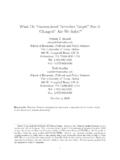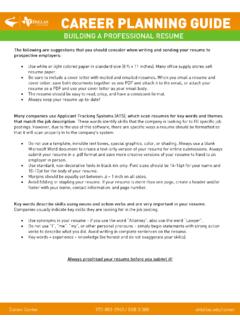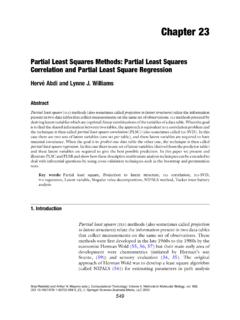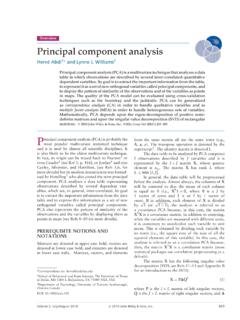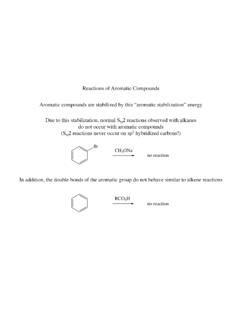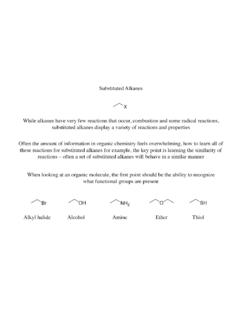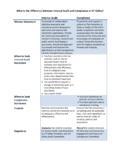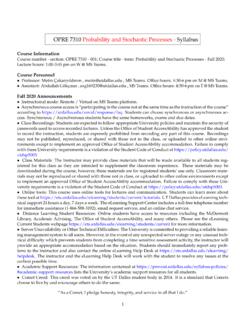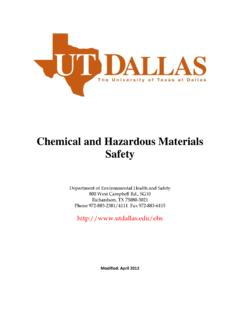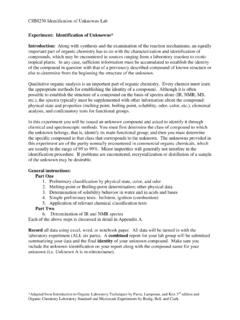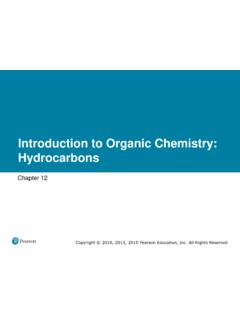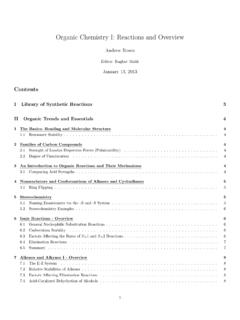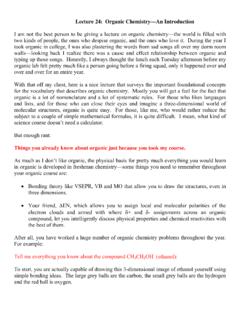Transcription of GUIDELINES FOR WRITING LAB REPORTS INTRODUCTION
1 CHEM 2123 and 2125 organic chemistry Lab I and II. GUIDELINES FOR WRITING LAB REPORTS . INTRODUCTION . WRITING REPORTS in organic chemistry lab may differ from the way it's done in general chemistry . One goal of this course is to introduce you to the record keeping methods used in research labs. Such methods are designed to organize experimental data in a format similar to that required for publication in major scientific journals. Here are some important considerations that apply in research settings. 1. Your work is unique, meaning that you might be the only person performing certain experiments. 2. Research is an ongoing process. The projects assigned to you will likely continue after you leave. People assigned to those projects will need to access your records for reference, or to attempt to reproduce work you did. Permanence is a characteristic of properly kept research records. 3. It is therefore important to follow GUIDELINES for clear WRITING .
2 In addition to WRITING legibly, you should use permanent ink. A ballpoint pen is adequate for this purpose, but a pencil is obviously not. 4. Write your records by hand, either while conducting the experiment, or immediately afterwards. This is important to avoid forgetting important details. You will make mistakes, but that is less important than recording data while it's still fresh in your mind. 5. Mistakes are not to be erased. A mistake might turn out to be important information later. You and others must be able to read what you wrote. If you make a mistake, draw a line across the text, but make sure it remains legible, like this. 6. Remember: your lab notebook is the first line of documentation that exists of your experiments. It is important that this information be as fresh and accurate as possible. Don't worry if it's imperfect. You will have occasion to produce a formal, well written report later. It may be a thesis or a scientific publication, but it will likely bring together several experiments with a common theme.
3 Your lab notebook will be the primary source of data for such publication. 7. Do not write on loose sheets of paper, or even in spiral notebooks from where pages can be torn. Use a hardbound notebook, with numbered pages, that makes carbon copies as you write. That makes it easy to spot missing pages, and it gives you two sets of records that you can keep in separate locations in case one of them gets lost or damaged. 8. Do not tear pages from a research notebook unless they're damaged or threaten the integrity of the notebook (by catching acid, for example). If both original and copy get damaged, try to reproduce their contents the best you can, with a note explaining the absence of the originals. TYPES OF REPORTS HANDLED IN THESE COURSES. In the organic chemistry lab course there are two types of REPORTS , which are all graded on a 100 point scale. One type comprises what's commonly known as lab REPORTS , that is, records referring to experiments performed in the lab.
4 The other type refers to special assignments that are completed outside the laboratory. The format and contents of special assignments depends on their nature. They are specified in the syllabus, or at the time the assignment is made. Examples are the MSDS assignment in organic lab I, or the Chemical Literature assignments in organic lab II. Lab REPORTS , on the other hand, have a set format. They can be or two kinds, depending on whether they refer to experiments involving physical operations or chemical preparations (synthesis). 2. LAB REPORTS FOR PHYSICAL OPERATIONS, OR TECHNIQUE EXPERIMENTS. This type of report refers to lab work whose main objective is to learn, demonstrate, or perform a physical operation. Physical operations do not change the chemical nature of the substances involved. They are typically conducted as part of a synthesis and are frequently of two types: 1. Purification techniques, or separations. These operations are designed to isolate a pure substance from a mixture.
5 Examples are crystallization, extraction, and distillation. 2. Characterization techniques. These operations are designed to return information that can be used to identify a substance. Examples are the determination of physical constants such as melting point, boiling point, or density, and instrumental techniques such as infrared (IR) spectroscopy. Sometimes these techniques are referred to as analytical techniques. LAB REPORTS FOR CHEMICAL PREPARATIONS, OR SYNTHESIS. This type of report refers to experiments whose main goal is to prepare a pure substance from specific starting materials. This necessarily involves a chemical transformation, or reaction. In the simplest case, there is only one step. The starting materials are combined and a product forms. This product is isolated, purified, and characterized, producing the final outcome of the experiment. In a multistep synthesis, the product of the first step is used as a starting material in a second step, and so on, until a final product is obtained.
6 No multistep syntheses are performed in organic lab I. Some two step syntheses are performed in organic lab II. FORMAT AND GRADING CRITERIA FOR PRELABS AND LAB REPORTS . The general format for most prelabs and lab REPORTS is given below. Specific differences with examples will be discussed later. You are expected to include the following items in your lab notebook. All prelabs and lab REPORTS are graded on a 100 point scale with the following distribution. INDIVIDUAL PRELAB (100 pts). Due at the beginning of each experiment. 1 NAME, EXPERIMENT #, TITLE, DATE, INSTRUCTOR, and SECTION. INTRODUCTION . 60 points a. Objectives of the experiment b. Table of physical constants Equally distributed among 2 c. Chemical equations and reaction mechanisms (for synthesis the items actually only). required for specific d. Diagram or sketch of setup used (if it serves for illustration experiments. purposes or to enhance clarity). EXPERIMENT OUTLINE (abbreviated list of experimental steps) 40 points 3 or Include either outline or FLOW CHART (diagram clearly showing the flow of operations) flow chart, not both.
7 GROUP LAB report (100 pts). Due a week after concluding the experiment. 1 NAMES OF GROUP MEMBERS, EXPERIMENT #, TITLE, DATE, INSTRUCTOR, and SECTION. 2 OBSERVATIONS OF PHYSICAL CHANGES 30 points 3 TABLE OF RESULTS (with supporting materials) 30 . 4 RESULTS, DISCUSSION, and CONCLUSIONS 30 . 5 ASSIGNED PROBLEMS (from the textbook) 10 . 3. INTRODUCTION Depending on the type of experiment being performed, this section may contain the items shown below. The first two are relevant to all experiments. The last two are relevant to some experiments. If you cannot find some of the required information in textbooks and common sources such as MSDS or the Aldrich catalog, simply indicate so. If the information is not pertinent, write N/A for not applicable. If it is unknown, indicate so. a. Objectives of the experiment b. Table of physical constants c. Relevant chemical equations and reaction mechanisms (in the case of synthesis). d. Diagram or sketch of setup used (if it serves for illustration purposes or to enhance clarity).
8 Objectives can be learning objectives and/or experimental objectives. For example, in a crystallization experiment the learning objective is to illustrate the technique of crystallization by having the student perform the steps involved. But the experiment objective is to purify a substance by crystallization and prove that it is reasonably pure by its melting point. A table of physical constants should include the following for every major chemical used in the experiment: chemical structure, molecular weight, boiling and/or melting point, density, and safety hazards such as flammability and toxicity. Under safety hazards, indicate the source of information with a footnote (Aldrich catalog, MSDS, etc.). If the substance poses special hazards, make a note under the table regarding safe handling and emergency procedures in case of contact. An MSDS must always be consulted before handling hazardous substances. Synthesis REPORTS must include chemical equations.
9 Include molecular mass and amounts used, in grams and in moles, for each reactant. This will enable you to find out which is the limiting reagent when the time comes to calculate the percent yield of the product. If the mechanism of the reaction is known (given in your book or in class), make sure to include it too. A picture can save you many words. If it serves an illustrative purpose, the INTRODUCTION can also include a diagram or sketch of the setup used, such as a distillation apparatus. It doesn't have to be a work of art and it doesn't need to be done every time a distillation is performed. If you do distillations again, simply refer the reader to the first experiment where the setup was used, or to a source such as an article or book. Examples of different parts of a lab report are given at the end of this guide and in your textbook. EXPERIMENT OUTLINE or FLOW CHART OF OPERATIONS An experiment outline is a list of the steps that go into performing an experiment, written in abbreviated form.
10 The main purpose of this list is to save time by serving as a quick reference while performing the experiment. Most experimental descriptions in the textbook tend to be verbose and difficult to follow, usually covering several pages. By distilling these descriptions into a list of steps the student is able to perform the experiment faster, requiring less assistance from the instructor(s). A flow chart of operations (like those used in engineering) is similar to a list of steps, except that it relies on pictures, arrows, and brief descriptions rather than words. The choice of outline or flow chart depends strictly on the student's personal preference, although some experiment may lend themselves better to one or the other. OBSERVATIONS OF PHYSICAL CHANGES As you perform the experiment, some physical changes may or may not happen. For example, when you combine two substances, a change in color might occur, the solution might get hot, a precipitate may form, or bubbles might appear.
